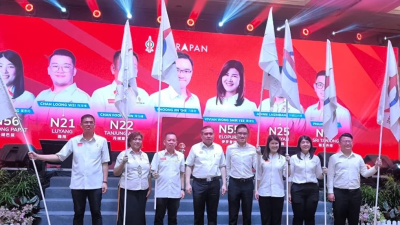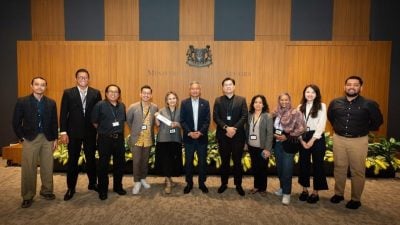
By Kazushi Shimizu
After years of talks, leaders from the fifteen East Asian countries signed a Regional Comprehensive Economic Partnership (RCEP) agreement during the 4th RCEP summit meeting held on November 15 in the midst of growing protectionism and the global spread of the COVID-19 coronavirus. This agreement has significant meaning for both Asean and the East Asian economy.
The RCEP is a mega-free trade agreement (FTA) for East Asia, a global growth center. There have been no mega-FTAs between East Asian nations, except for the Asean Economic Community (AEC) and the Asean+1 FTAs. The members of the new RCEP trading arrangement represent around 30% of the world’s gross domestic product (GDP), population and trade, and it is the first FTA that Japan, China and South Korea have agreed upon.
The purpose of the RCEP is to be an economic partnership agreement (EPA) that is modern, comprehensive, high-quality and mutually beneficial to enable economic collaboration between East Asian nations. One feature of the RCEP is Asean Centrality in East Asia, and the RCEP aims at forming a larger FTA than the existing Asean+1 FTAs. The agreement has twenty chapters, covering a range of areas regarding trade liberalization and rules, including Trade in Goods (Ch. 2), Trade in Services (Ch. 8), Investment (Ch. 10), Intellectual Property (Ch. 11), Electronic Commerce (Ch. 12), Competition (Ch. 13), and Economic and Technical Cooperation (Ch. 15).
While achieving some improvement over the existing Asean+1 FTAs, there seem to be some issues with certain RCEP items, such as Trade in Goods, some of which seem to take a longer time to eliminate tariffs while some tariffs will be removed immediately. Overall, tariffs will likely be eliminated on 91% of all products. Meanwhile, the rules of the RCEP are not as strict as the Trans-Pacific Partnership (TPP).
Having said that, I would like to welcome that the agreement has actually been signed after years of talks in the midst of a challenging global economy. I believe it will be essential for the participating nations to improve and expand the agreement step by step after the establishment of the scheme. The RCEP should follow a development process similar to the Asean Free Trade Area (AFTA), which has been promoted by the Asean, because the RCEP is a mega-FTA established by countries that differ significantly in terms of their stage of economic development. It will be important for each member country to benefit from the scheme in pursuit of its continued development.
The first benefit of the RCEP is the encouragement of trade and investment in goods and services across Asean and East Asia, contributing to the continued economic development of the region as a whole. Second, it will contribute to the establishment of rules for new areas such as intellectual property and electronic commerce. Third, it will facilitate the establishment of production networks or supply chains in Asean and East Asia. Fourth, the RCEP is expected to help narrow the economic gaps between advanced and developing countries within the region.
The RCEP is very significant for Asean because it will contribute to the economic development of Asean going forward. It will eventually help Asean countries secure Asean Centrality in the context of the regional cooperation with their counterparts in East Asia. The RCEP is a mega-FTA proposed and promoted by Asean, not by Japan or China. It was first proposed by Asean in November 2011 as a new FTA for East Asia, and Asean has since taken steps toward the realization of the RCEP. Asean has been a key part of RCEP negotiations, and this seems to have facilitated the participation of Japan, China, Australia and New Zealand in the negotiation process. For Asean countries, it seemed important to continue to maintain Asean Centrality under this scheme going forward.
The RCEP is also very significant for Japan because it accounts for half of the trade value of Japan. The RCEP, once established, became Japan’s third mega-FTA, behind the Comprehensive and Progressive Agreement for Trans-Pacific Partnership (CPTPP or TPP11) and the Japan-EU EPA that the country had promoted.
China expected to join a mega-FTA during its conflicts with the United States. At the same time, it seemed that China joining the RCEP framework was important to RCEP member nations for future trade within the scheme. Unfortunately, India declined to sign onto the agreement this time around, but the door remains open to India’s entry in the future. I hope India will reenter the agreement soon.
The signing of the RCEP is expected to trigger nations to overcome the challenging situation of the growing protectionism confronting us today. Protectionism could have big negative impacts on the Asean and East Asian economies. The CPTPP and the Japan-EU EPA promoted by Japan have already been enacted. This third mega-FTA signing is expected to have a significant positive impact.
The Biden administration will take office next January. It is expected that the Biden administration will shift trade policy from bilateral to multilateral negotiations. Given this, the signing of the RCEP mega-FTA in East Asia will have a major impact on US trade policy.
I hope that the RCEP will trigger the gradual overcoming of the challenging global economic situation characterized by protectionism. It seems essential for the Asean and East Asian economies to have a framework ensuring free trade and investment. I hope the RCEP will significantly impact post-pandemic economic growth in Asean and East Asia.
(Kazushi Shimizu is Professor at Kyushu University, Japan.)
ADVERTISEMENT
ADVERTISEMENT


































